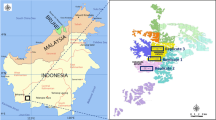Abstract
The nitrogen, phosphorus and potassium requirement of sunflower was evaluated when the crop was grown on siliceous sands overlying clay in the south east of South Australia. Of the seven sites used in the investigation, significant seed yield responses to phosphorus were recorded at two, while at a further two sites seed yields were increased by potassium additions. Nitrogen applications did not significantly increase seed yields at any site but decreased seed yields at two. This lack of nitrogen response was attributed to the sites having been long term legume pastures prior to the sunflower crops.
Oil concentrations of sunflower seed ranged from 40.6% to 45.3% between sites, but fertilizer treatment had no significant effect.
Critical nutrient ranges for both soil (Colwell) extractable phosphorus and potassium were derived at maximum seed yield. These were 16–20 mg kg−1 for extractable phosphorus and 70–80 mg kg−1 for extractable potassium.
Similar content being viewed by others
References
Blackburn G (1959) Soils of county Grey, South Australia. CSIRO Aust. Soils Land Use Ser No 33
Blackburn G (1964) The soils of counties MacDonnell and Robe, South Australia. CSIRO Aust. Soils Land Use Ser No 45
Blamey FPC and Chapman J (1981) Protein, oil and energy yields of sunflower as affected by N and P fertilisation. Agron J 73: 583–587
Blamey FPC, Edwards DG and Asher CJ (1987) Nutrition disorders of sunflower. Dept Agric, University of Queensland, St Lucia Queensland
Campbell NA and Keay J (1970) Flexible techniques in describing mathematically a range of response curves for pasture species. Proceedings 11th International Grasslands Congress Surfers Paradise, Qld, 1970. (Ed. MJT Norman) pp 332–334 (University of Queensland Press St. Lucia, Qld)
Colwell JD (1963) The estimation of phosphorus fertiliser requirements of wheat in southern New South Wales by soil analysis. Aust J Exp Agric Anim Husb 3: 190–197
Cope JT and Evans CE (1985) Soil testing. In Advances in Soil Science Vol 1 Edited by BA Stewart, Springer-Verlag, New York Inc pp 201–228
Dow AI and Roberts S (1982) Proposal: critical nutrient ranges for crop diagnosis. Agron J 74: 401–403
Hibberd DE Hunter MN Standley J Whitehouse MJ Moody PW Want PS and Grant IJ (1984) Phosphorus fertiliser investigations with sunflowers on a cracking clay of low P status at Emerald, Central Queensland. Proc 5th Workshop Australian Sunflower Association, Emerald: pp 12–16
Hunter MN and Kochman JK (1985) Severe phosphorus deficiency in sunflower — the cause of foliar symptoms similar to those produced by some fungal pathogens. Helia 8: 57–62
Hunter MN and McCosker AN (1982) Interactions between moisture supply, N and P, in the performance of an open pollinated and a hybrid sunflower variety in a semi-arid environment. Proc 10th Int Sunflower Conf Surfers Paradise: 88–91
Lewis DC and Clarke AL (1975) Superphosphate for acid South-East sands. J of Agric South Aust 78: 74–77
Lewis DC and Meissner AP (1985) The effect of previous fertiliser treatments on the current response in pasture production to phosphorus, sulphur and potassium in the south east of South Australia. Ag Record 12: 19–22
Lewis DC Clarke AL and Hall WB (1987a) Accumulation of plant nutrients and changes in soil properties of sandy soils in south eastern South Australia. I. Phosphorus. Aust J Soil Res 25: 193–202
Lewis DC Clarke AL and Hall WB (1987b) Accumulation of plant nutrients and changes in soil properties of sandy soils in south eastern South Australia. II. Total sulphur and nitrogen, organic carbon and pH. Aust J Soil Res 25: 203–210
Meissner AP and Clarke AL (1977) Response of mown pasture to potassium fertiliser in south-eastern South Australia. Aust J Exp Agric Anim Husb 17: 765–775
Northcote KH (1971) A factual key for the recognition of Australian Soils, (third edition) Rellim Technical Publications, Glenside (South Aust)
Riceman DS (1948) Mineral deficiency in plants on the soils of Ninety-Mile plain in South Australia. CSIRO Bulletin No 234
Smith FW and Dolby GR (1977) Derivation of diagnostic indices for assessing the sulphur status of Panicum maximum var. trichoglume. Commum Soil Sci Anal 8: 221–240
Spencer K and Chan CW (1981) Critical phosphorus levels in sunflower plants. Aust J Exp Agric Anim Husb 21: 91–97
Zubriski JC and Zimmerman DC (1974) Effects of nitrogen phosphorus and plant density on sunflower. Agron J 66: 798–801
Author information
Authors and Affiliations
Rights and permissions
About this article
Cite this article
Lewis, D.C., Potter, T.D. & Weckert, S.E. The effect of nitrogen, phosphorus and potassium fertilizer applications on the seed yield of sunflower (Helianthus annuus L.) grown on sandy soils and the prediction of phosphorus and potassium responses by soil tests. Fertilizer Research 28, 185–190 (1991). https://doi.org/10.1007/BF01049749
Received:
Accepted:
Issue Date:
DOI: https://doi.org/10.1007/BF01049749




